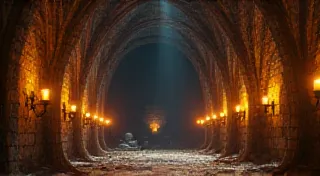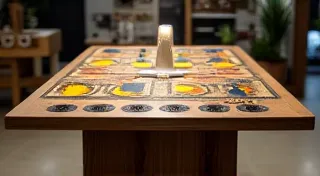The Obsidian Compass: Navigating the Ethics of Player Agency
There's a peculiar melancholy that clings to antique accordions. They sit, often neglected, their bellows collapsed, their keys yellowed and silent. Each one holds a story, a history of hands that coaxed music from their reeds, of laughter and tears echoing within their wooden frames. My grandfather, a taciturn man of few words, played one. I remember, as a child, the almost ritualistic way he’s draw it from its case, the careful dusting, the measured press of a button to inflate the bellows. The music that followed wasn't joyous, not precisely; it was a wistful melody, a conversation with the past. It felt…guided. He wasn't improvising wildly, but following a path, a pre-ordained sequence of notes. It planted a seed in me – a thought about direction, about being led, about the subtle power of seemingly inevitable sequences.
That feeling, that quiet acceptance of a pre-determined course, resonates deeply within the world of board games. Player agency – the illusion of choice – is a cornerstone of engaging gameplay. We celebrate games that make us feel like architects of our own destinies, the masters of our own fates. But where does agency end and manipulation begin? It's a question that increasingly occupies game designers, and one that deserves careful consideration. Because a game that feels like it’s subtly pulling the strings, guiding you toward a pre-ordained outcome, isn't just less fun; it can be ethically questionable.

The Psychology of Choice Architecture
The concept of "choice architecture," popularized by Richard Thaler and Cass Sunstein in their book *Nudge*, provides a useful framework for understanding the ethical tightrope game designers walk. Choice architecture refers to the ways in which the presentation of choices influences our decisions. It’s not about eliminating choice; it’s about designing environments that nudge people toward desired outcomes without overtly restricting their freedom. Consider a restaurant menu. Items placed at the top and bottom of the menu are more likely to be ordered, regardless of their actual value or tastiness. This isn’t inherently malicious; it’s a standard marketing tactic. But it demonstrates how the arrangement of options can sway our preferences.
Game designers use similar techniques, often unconsciously. Certain card draws being more likely, resource distributions that favor specific strategies, even the color scheme of the board – all these elements subtly push players toward particular choices. This isn't always a bad thing. A well-designed game *should* guide players, introducing them to core mechanics and steering them away from dead ends. The problem arises when this guidance becomes coercion. When the illusion of agency is shattered by the realization that the game is, in fact, leading you down a very specific path, with limited opportunity for genuine deviation.
The Craftsman's Touch: Hidden Paths and Subtle Influences
Think about the meticulous craftsmanship required to build an accordion. Each reed, painstakingly aligned and tuned; each button, carefully placed to facilitate a specific action. The artisan isn't creating a chaotic jumble of parts; they're constructing a system, a machine that produces a predictable outcome. It’s a form of control, but it's also an act of creation. Similarly, game designers are architects of experiences, crafting systems that evoke specific feelings and encourage particular behaviors.
However, the difference lies in transparency. An accordion player understands that the instrument dictates the possible sounds. They may improvise within those constraints, but they are aware of the limitations. In games, the system often obscures its influence. A player might think they’re making a strategic decision, only to realize that the game’s design subtly stacked the odds in favor of that outcome. This erosion of trust can significantly diminish the enjoyment and sense of accomplishment.
Consider a game with asymmetrical factions. If one faction is consistently perceived as vastly superior, despite the design’s intent to balance them, the player choosing that faction is not exercising true agency. They are simply opting for the path of least resistance, dictated by the game's inherent imbalance. The illusion of choice remains, but the satisfaction of genuine strategic mastery is lost.
Restoration, Revelation, and Respect for the Design
There's a fascinating parallel between restoring an antique accordion and analyzing a game's design. Both require a deep understanding of the underlying mechanics and a respect for the original intent. A skilled accordion restorer doesn't simply slap on a new finish; they meticulously repair damaged reeds, replace worn bellows, and ensure that every component functions as originally designed. They are uncovering the instrument’s true potential, revealing its hidden beauty.

Similarly, critically evaluating a game’s design often involves dissecting its mechanics and identifying the subtle ways in which it influences player choices. It’s not about condemning the design; it’s about understanding it. It's about recognizing when a design's guiding hand becomes a controlling fist. It’s about appreciating the artistry, even while acknowledging its potential flaws.
The best game designers are those who find the sweet spot – the place where guidance and freedom coexist. They understand that true agency isn't about providing infinite possibilities; it’s about providing meaningful choices within a well-defined framework. They are like the craftsman who, through careful planning and meticulous execution, creates an accordion that is both reliable and expressive, a machine that inspires music and allows for a degree of improvisation.
The Future of Agency: Transparency and Player Empowerment
As board games evolve, so too will our understanding of player agency. There’s a growing movement toward greater transparency in game design – providing players with more information about the probabilities and mechanics that govern the game. This doesn’t necessarily diminish the fun; it can actually enhance it, allowing players to make more informed decisions and appreciate the design on a deeper level.
Furthermore, we're seeing a rise in games that explicitly empower players to customize their experiences – offering variable setup options, modular components, and even tools for creating their own content. These games recognize that true agency isn't about being told what to do; it’s about having the freedom to shape the game to one's own preferences.

The obsidian compass, a metaphor for the guiding force within a game, shouldn't dictate the journey entirely. It should provide direction, inspire exploration, and ultimately allow players to chart their own course – even if that course occasionally deviates from the predetermined path. And like the lingering echo of music from an antique accordion, the memory of a truly engaging game should resonate long after the final pieces have been cleared from the table, leaving a feeling of accomplishment, not manipulation.





